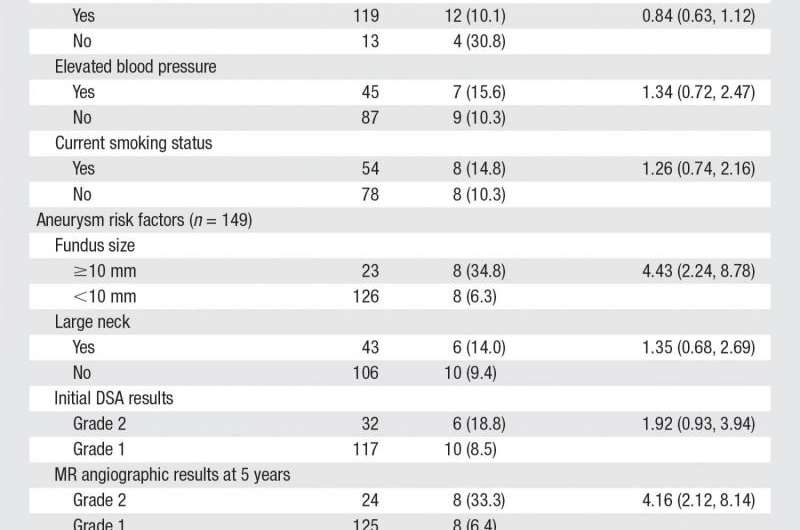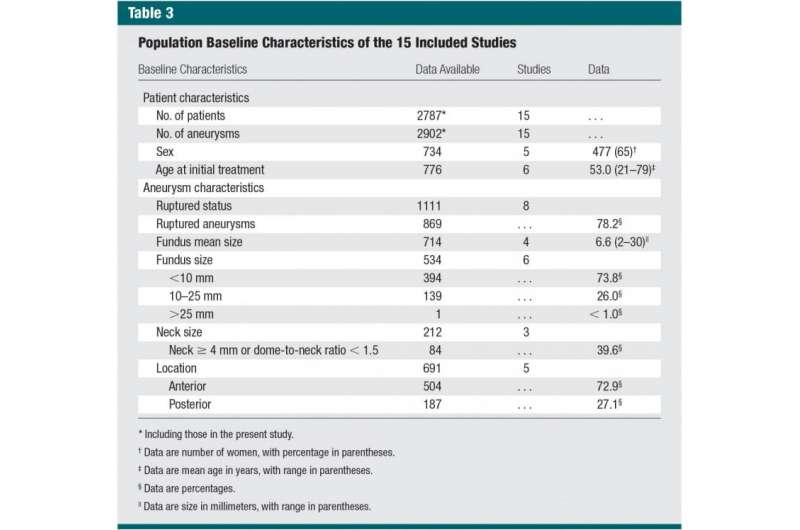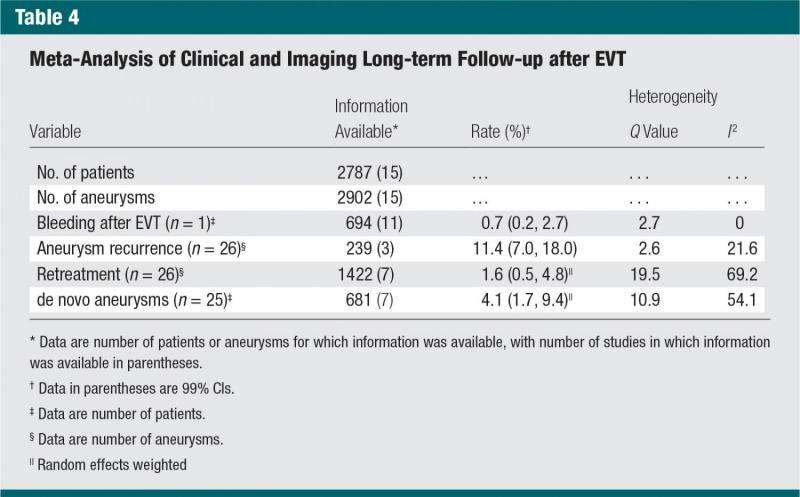Aneurysms may recur years after endovascular treatment

Endovascular treatment (EVT) of intracranial aneurysm is effective in preventing long-term bleeding, but may be followed by aneurysm recurrences in a significant proportion of cases, according to a new magnetic resonance angiography (MRA) study published online in the journal Radiology.
Intracranial aneurysm is a weak or thin spot in a blood vessel in the brain that balloons and fills with blood. It can leak or rupture, leading to a potentially fatal cerebral hemorrhage.
EVT with coils was developed in the 1990s and became an established treatment for intracranial aneurysm in the early 2000s. In EVT, coils are threaded via a micro-catheter through a blood vessel in the groin to the location of the aneurysm. The coils expand and cause formation of a clot in the aneurysm that provides a seal, or occlusion, to prevent further bleeding.
The main drawback of endovascular treatment is recanalization, or a return of blood flow into the original aneurysm. Previous studies on the clinical significance of this have followed a limited number of patients for relatively short periods.
For the new study, researchers looked at the long-term efficacy of EVT in preventing aneurysm ruptures. They performed clinical examination and 3-Tesla MRA 10 years after EVT of intracranial aneurysm in a single institution. In addition, they reviewed results from the medical literature to identify studies reporting bleeding and/or aneurysm recurrence rate in patients followed beyond 10 years after EVT.
Among 129 aneurysms followed for more than10 years, 16, or 12.4 percent, demonstrated recanalization between midterm and long-term MRA. Incomplete occlusion on midterm MRA and retreatment within five years were risk factors for late recurrence. The literature review of 2,902 aneurysms showed that incomplete occlusion and aneurysm size of greater than 10 millimeters were risk factors for late recurrence.

The results show that while EVT is effective in preventing long-term bleeding, patients with larger aneurysms or incomplete occlusion face a long-term risk of aneurysm recurrences.
"This result is of importance since a large proportion of patients in the study were young, with a mean age of 47 years," said Olivier N. Naggara, M.D., Ph.D., from the Centre Hospitalier Sainte-Anne in Paris. "Consequently, demonstration of the efficacy of prevention of rupture more than 10 years after treatment is a crucial point."
If supported by additional research, the findings may mean that longer follow-up protocols are necessary for some intracranial aneurysm patients who undergo EVT.

"We believe that the subgroup of patients with aneurysm size 10 millimeters or more and patients with incomplete occlusions should be followed by noninvasive imaging exams for 10 years or more, particularly young patients," Dr. Naggara said.
EVT can be repeated to prevent a potential angiographic recurrence. However, more research is needed, Dr. Naggara said, to develop a clearer picture of the risks and benefits of this approach.
"Retreating a recurrent aneurysm with additional coils may fail in up to 50 percent of cases," he said. "Adjunctive techniques we add to standard coiling, such as modified coils, stents and flow diverters, have demonstrated lower recurrence rate after EVT but may involve more risks than simple treatment with platinum coils."
More information: "Intracranial Aneurysms: Recurrences More than 10 Years after Endovascular Treatment—A Prospective Cohort Study, Systematic Review, and Meta-Analysis" Radiology, 2015.
















